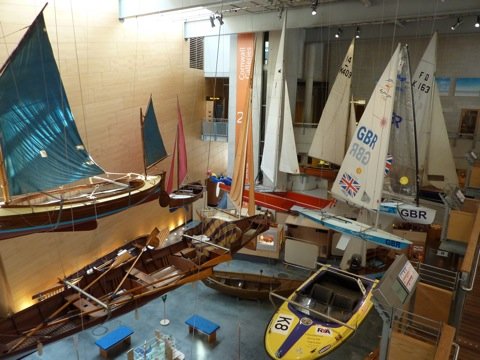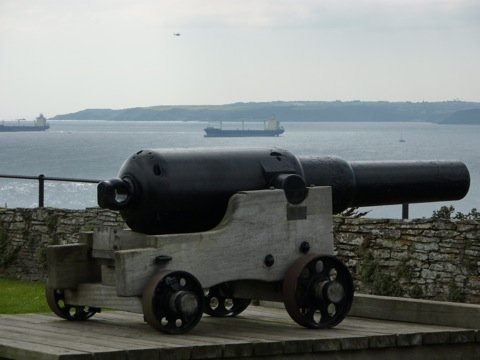
After my little misadventure at Camelford, I started the next day out of position, and had a long way to go just to get back to my real hotel in Truro for a change of clothes. So for my day’s excursion I didn’t want to go too far from Truro, and luckily Falmouth is only a short trip by train.

What does Falmouth have? Yachts!

Ships!

Even a quasi-aircraft-carrier-cum-hospital ship (technically an aviation training and casualty receiving ship), RFA Argus, a veteran of wars from the Falklands to Iraq.

Falmouth has a deep harbour and a long nautical tradition, so it was a logical place to put the National Maritime Museum Cornwall. Unlike the National Maritime Museum in London (of which it is independent), the focus is more on small craft than big ships.

For example, this is a model of a fishing boat called Mystery. In 1854-5 its owners sailed it from Newlyn in Cornwall to Melbourne and back, looking for work!

A working replica of one of the first submarines, built by Dutchman Cornelius Drebbel for the Royal Navy in the 17th century. (They didn’t want it.)

A string vest which Ernest Shackleton wore during his Imperial Trans-Antarctic Expedition in 1914-7. Despite the undoubted historical significance of this artefact, I must admit it made me think of this.

Victoria by the grace of God did grant somebody something … sorry, I don’t know what this is for, exactly. I just liked the calligraphy!

The other major attraction at Falmouth (for me, at least) was Pendennis Castle.

Pendennis is part of the Tudor harbour defences.

As such, where Falmouth in general is characterised by ships, Pendennis Castle is characterised by guns with which to sink them. (Well, to sink the enemy’s ships, but you get the idea.)

This a (reproduction) Tudor cannon, (mock) firing through a (glass-covered) gunport (but with real smoke).

An array of late-18th/early-19th century guns. A ship of the line could carry more, but it also was made of wood and could sink.

This looks mid-to-late 19th century to me — still muzzle-loading, anyway.

A technological advance in the 1890s — breech loading.

Although this example now has a fixed position, it originally had a disappearing mount: it would rise above the parapet to fire, and then would sink below to be reloaded. Too much wear and tear; these were replaced in 1913. The concrete structure in front of the emplacement was built in the First World War, and served in the Second as an aircraft spotting station.

Speaking of aircraft, here’s an anti-aircraft gun. (There’s also a First World War-vintage 3-inch AA gun, but my photo of that is boring, to be honest.)

One of the two big 6-inch guns in the Half-Moon Battery, dating from the Second World War. Radar-directed, with a range of 12 miles.

Turning to the architecture, this is the Henrician tower. Construction began in 1539: the threats it guarded against were France and Spain. (The upper left window is, I think, the gunport shown several photos ago.)

A view from the tower’s battlements.

English Heritage’s flag flying proudly over the keep. (Not that Cornish nationalists would be proud of it.)

Little Dennis — a Tudor blockhouse built right out on the tip of the point.

Some different views of Falmouth and surrounds. St Anthony’s Lighthouse, across the Carrick Roads from Pendennis,

Part of the harbourside memorial to the raid on St Nazaire, which set sail from Falmouth on 26 March 1942.

For some reason, I like the idea of having a back door which leads directly to the sea …
![]() This work is licensed under a Creative Commons Attribution-NonCommercial-NoDerivatives 4.0 International License.
Permissions beyond the scope of this license may be available at http://airminded.org/copyright/.
This work is licensed under a Creative Commons Attribution-NonCommercial-NoDerivatives 4.0 International License.
Permissions beyond the scope of this license may be available at http://airminded.org/copyright/.


Allow me to be the first to volunteer to go to sea in a wooden, 17th century submarine. What could possibly go wrong?
Supposedly James I and VI had a go in it (though in the Thames not at sea). So it should be good enough for commoners.